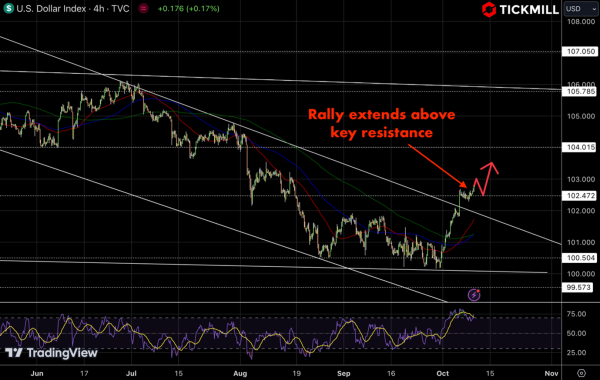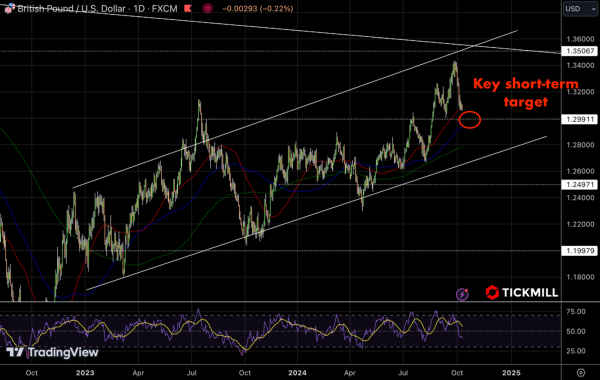Market Analysis: USD Strengthens Amid Hawkish Fed Expectations and Geopolitical Tensions
The greenback extends its winning march, pushing the EUR/USD pair to an eight-week low near 1.0950 during Wednesday's New York session. The USD's rally is supported by rising US Treasury yields and shifting expectations around the Federal Reserve's monetary policy. Simultaneously, GBP/USD trades cautiously below the 1.3100 resistance level, succumbing to the pressure of the US currency. Geopolitical tensions in the Middle East have further amplified the USD's appeal as a safe-haven asset.
The Dollar Index (DXY) has successfully broken out of a major bearish channel, signaling a potential shift in the medium-term trend. After breaching the 102.50 level, which acted as a critical short-term resistance, the price experienced a brief period of consolidation, establishing a new foothold above this key level. This breakout suggests further upside momentum, with the next target set around the 103.50 zone, though a potential pullback could occur due to overstretched short-term momentum indicators:

The upbeat September NFP report, which exceeded market expectations, has reinforced the view that the US economy remains resilient. This reduces the likelihood of imminent rate cuts. This led to the situation where market participants have scaled back expectations for near-term interest rate cuts by the Fed. According to the interest rate futures, the implied chance of a rate cut in the remaining two policy meetings this year has diminished significantly, to 25 bp only.
US Treasury yields have climbed as investors adjust to the prospect of higher interest rates for longer, increasing the USD's attractiveness.
The minutes from the September meeting due today will provide valuable insights into the Fed's assessment of the economy and inflation, as well as the deliberations surrounding future policy moves.
September CPI figures, slated for release on Thursday, will shed light on inflationary pressures. A higher-than-expected reading could reinforce expectations of prolonged higher rates. US PPI data, which will be released on Friday, will offer additional insight into wholesale inflation trends, potentially impacting future Fed decisions.
Escalating tensions between Israel and Iran have injected volatility into global markets. The risk-off sentiment has prompted investors to seek safe-haven assets, benefiting the USD and weighing on risk-sensitive currencies. S&P 500 futures have posted losses during European trading hours, reflecting broader risk aversion.
On the Euro side, the ECB faces challenges with sluggish growth and persistent inflation, limiting its ability to tighten monetary policy further. This contrasts with the Fed's relatively hawkish stance. Recent Eurozone data, especially retail sales and the inflation report, pointed to rising stagflation risks, adding downward pressure on the Euro.
The Bank of England is grappling with high inflation and slowing growth. While the BoE has raised rates in previous meetings, uncertainty remains about future rate hikes. Investors are awaiting the UK's monthly GDP and industrial production figures for August, due on Friday, which could influence the BoE's policy trajectory.
The GBP/USD pair has experienced a downside bounce from the upper boundary of the ascending channel, suggesting that the upward momentum is losing steam in the short term. The key level at 1.30 remains a crucial target for sellers, and as long as this level holds, a significant reversal appears unlikely. This level acts as a psychological and technical resistance, and sellers are likely to maintain control until their target is met. The recent rejection from the upper channel boundary hints that any revival of the rally may be delayed, with consolidation or further downside expected in the near term:
